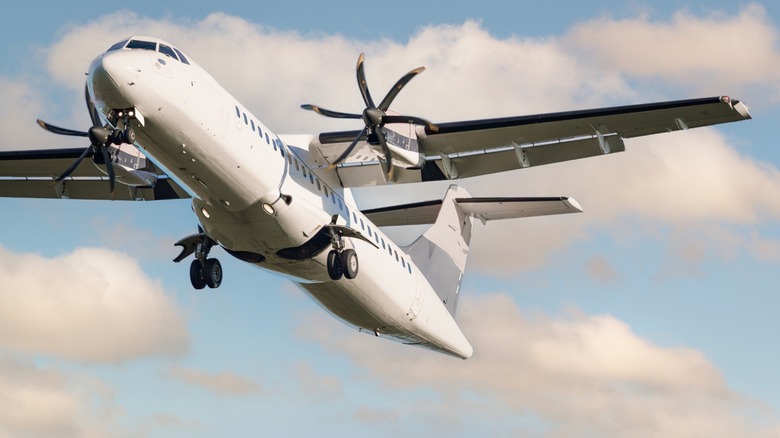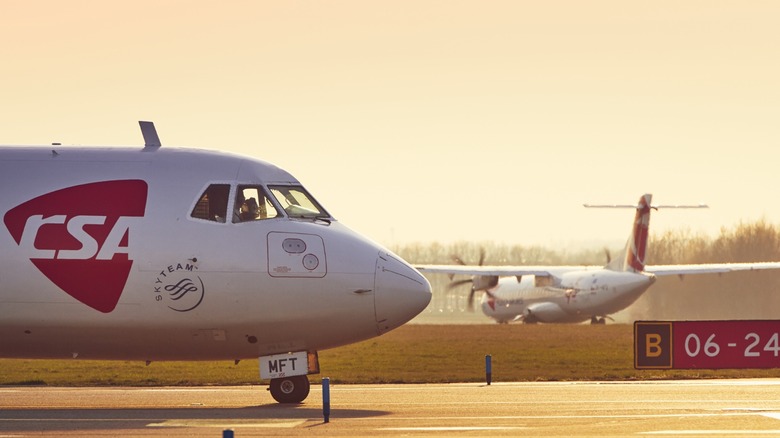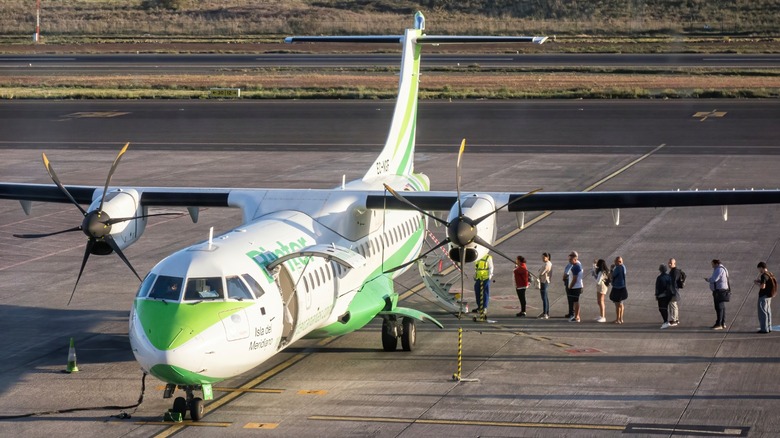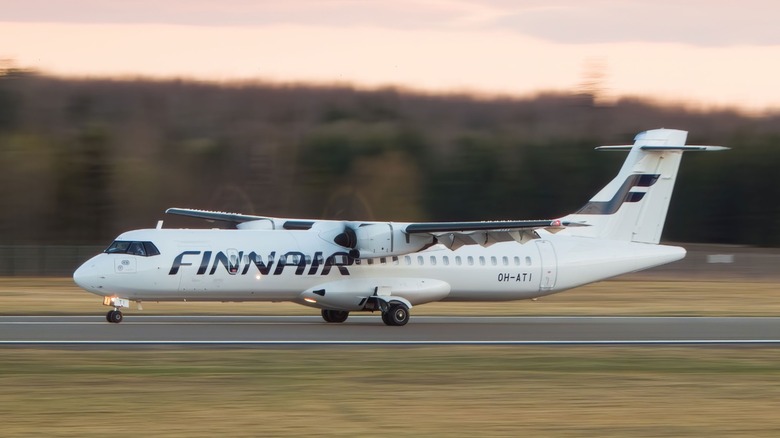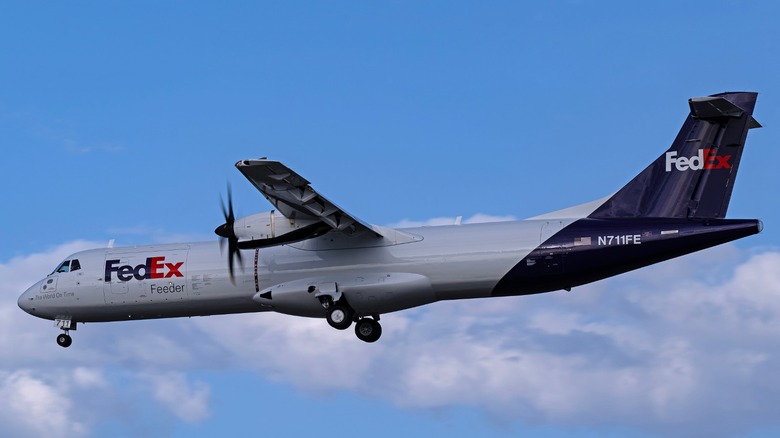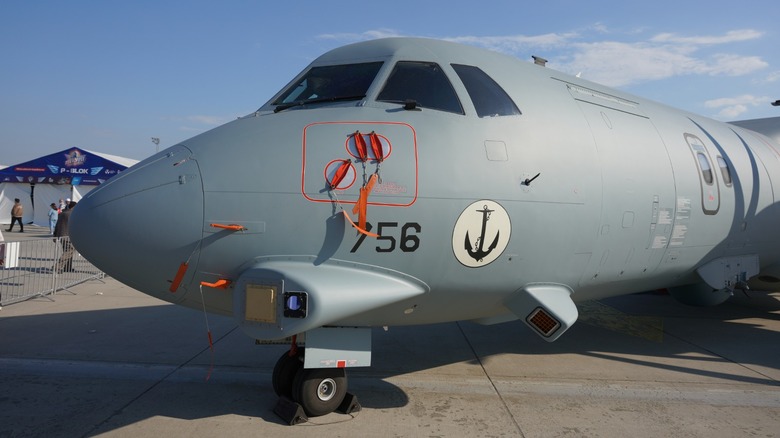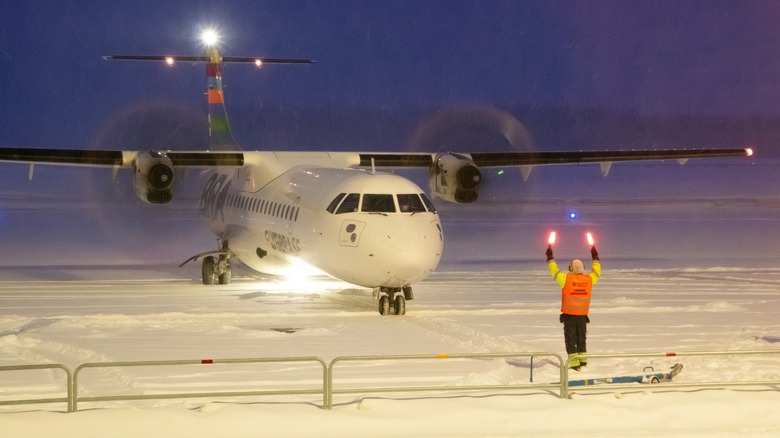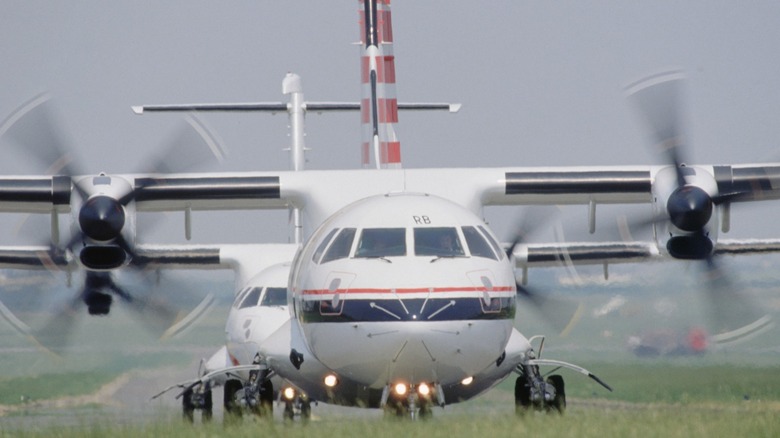Everything To Know About The ATR 72 Turboprop Plane
ATR makes popular turboprop regional airliners that fly less popular routes. The aircraft maker offers two major models, the ATR 42 and ATR 72, and they compete against other aircraft like the CRJ 700 and Embraer E-Jets. Because the ATRs are powered by turboprops, they're faster and more reliable than piston-engined airplanes while remaining cheaper to operate than turbofan or turbojet airliners.
It also has a feature that makes it more comfortable for both crew and passengers to operate on the ground. That's why many airliners favor operating them for lean routes and between airports with fewer ground services, with FlightGlobal reporting 775 active ATR 72 airframes flying as of 2019, with 171 more on order across 126 airlines. So, how did the ATR 72 come about, and why is it so popular? Let's explore everything to know about this regional turboprop airliner and see how it connects even the smallest airports to the rest of the world.
A stretched ATR 42
ATR aircraft first came about as a joint venture between French company Aerospatiale (now Airbus) and Aeritalia (now Leonardo S.p.A.). The company was called Aerei da Trasporto Regionale in Italian or Avions de transport régional in French, thus making the ATR name perfect for both cultures. The company designed the initial ATR 42 model to replace the aging Hawkey Sidley HS 748 and Fokker F.27 Friendship regional airliners. It was a rather successful design, with ATR having sold 400 units of the ATR 42 by 1989 — just four years after its initial flight.
But, even during the ATR 42's development and certification phase, the company was already working on the larger ATR 72. This plane was essentially a stretched version of the ATR 42, increasing its seating capacity from 40+ passengers to a maximum of 78. ATR did this by lengthening the fuselage by 4.5 meters or 15 feet and increasing its wingspan to accommodate the heavier weight while simultaneously giving it 10% more fuel capacity.
The ATR 72 took its first flight on October 27, 1988, and received its type certificate from the French Directorate-General for Civil Aviation the following year. The type's launch customer, Finnair, put its first ATR 72 into service exactly one year after the regional airliner's first flight.
Unique 'Hotel' mode
One of the things that made the ATR 72 popular among operators is the viability of its operations in smaller airports with fewer ground facilities. For example, the type's high-wing configuration meant that it was less prone to propeller ground strikes and foreign-object debris damage. This also meant that the fuselage would sit low to the ground, thus removing the need for air stairs to board and deplane passengers. Furthermore, the turboprop design of the ATR 72, especially its later variants, gives it relatively short take-off and landing distances compared to jet aircraft. This means airlines can put these planes into service at small airports without worrying about the runway length.
However, one feature that only the ATR offers for its models is the unique 'Hotel' mode. When parked on the ground, it's generally unsafe for aircraft to turn their engines, as it could suck up debris, equipment, or worse, personnel. Because of this, parked aircraft have to connect to a ground power unit (GPU) from the airport to power the aircraft and run its systems, like air-conditioning, to keep the aircraft cool. However, the GPU is not something that all airports have, especially the smaller ones that the ATR 72 is designed to serve.
Alternatively, larger jets usually have an auxiliary power unit (APU) to power their on-board systems. However, APUs are small engines that would often sit unused for most of the flight, thus making planes heavier. So, ATR solved this issue by installing a propeller brake on the right-hand engine. This allowed the pilots to run the engine at low speeds without making the propeller turn, thus keeping ground personnel safe while powering the aircraft, negating the need for an external GPU or a heavy APU.
Civilian and military operators
As said earlier, the ATR 72 is a popular model with many operators. While we would often assume that these are civilian airline operators, a few militaries also saw the utility of the aircraft, so they bought them as well. As of 2019, 126 airlines operate regional airliners, with some of the biggest operators including Wings Air (64 airframes with three more on order), Azul (33 airframes with 5 on order), and IndiGo (18 airframes with 32 on order). Even FedEx is getting into the game with 30 ATR 72-600s on order.
Aside from these civilian operators, the following militaries and armed forces have the ATR 72 in their equipment list: The Royal Malaysian Air Force (two on order), the Pakistan Navy (four airframes), and the Turkish Navy (two airframes). The Italian Air Force has two P-72A maritime patrol aircraft based on the ATR 72MP in its fleet, with two more slated for delivery. The Philippines also ordered two long-range patrol aircraft from Elbit Systems that will use the ATR 72-600 as its base.
ATR 72 airliner variants
The ATR 72 has four main civilian variants: The ATR 72-200, ATR 72-210, ATR 72-500, and the ATR 72-600. The ATR 72-200 was the first one to enter service, and it has a standard seating configuration of 66 to 72 seats. The ATR 72-210 had higher power engines, generating 350 shaft horsepower (shp) more at 2,750 shp for each engine versus the 72-200's 2,400 shp.
The next variant that ATR introduced in the ATR 72 family is the 72-500, which entered service in 1997. This model had an output of 2,500 shp in each engine and had six-bladed propellers for better efficiency. At the moment, the latest version of the ATR 72 is the 72-600. This variant gained six extra seats, bringing up its maximum capacity to 78 passengers.
It also now has an all-glass widescreen cockpit and an improved electronic flight information system (EFIS), thus making it easier to operate for pilots. Finally, ATR introduced the ATR 72-600F for FedEx's regional needs. This aircraft can accommodate up to 9.2 tons or 75 cubic meters of cargo and can fly up to 1,030 nautical miles based on its maximum volumetric payload.
Military ATR 72s
Aside from its civilian roles, the ATR 72 serves militaries primarily as a Command, Control, Communications, Computers, Intelligence, Surveillance, and Reconnaissance (C4ISR) aircraft through the ATR 72MP. Although unarmed in its primary role, the ATR 72MP is crucial in helping countries maintain the integrity of their maritime borders by monitoring their sea lanes and patrolling their exclusive economic zones (EEZs).
For the C4ISR role, the ATR 72MP comes with advanced radar systems, an electro-optical system mounted on a turret for long-range visual spotting, and search and rescue systems. It's also equipped with an IFF (Identification Friend or Foe) transponder, two independent navigation systems, and tactical cockpit displays.
The ATR 72MP could also operate in a tactical defensive role with its anti-submarine warfare (ASW) and anti-surface warfare (AsuW) capabilities. You could install defensive systems to allow the aircraft to operate safely in less-than-friendly airspace, and it could also be equipped with sonobuoy launch systems, acoustic detectors, and even a magnetic anomaly detector for finding submarines. Once a target is located, the ATR 72MP uses two light torpedoes carried in external fuselage pylons to engage it.
The ATR 72's icing issue
Although the ATR 72 is a popular and reliable aircraft, it's also known for its icing issue, with several crashes attributed to ice buildup. In fact, investigators are looking at icing as one of the causes of the crash of the ATR 72 in Brazil last August. Ice on aircraft in flight is potentially dangerous, as it could disrupt airflow over the wings and engines.
When this happens, the airplane's wings could lose lift and cause it to stall. Aside from that, ice adds weight to the aircraft, reducing its flight performance, and it could also build up on flight surfaces, making it more difficult for the pilots to control the airplane. It's for this reason that proper de-icing is crucial for all kinds of aircraft, whether large or small.
How the ATR 72 kept the smaller model alive
Given that the ATR 72 is a derivative model of the ATR 42, both aircraft had many common parts. So, because of the popularity of the former, the latter was able to stay in production despite all other 50-seat and below regional airliners no longer being produced. This is unlike what happened to the competing Bombardier Q200/300 turboprop planes that had their own production line separate from the larger Q400 and had to stop production in 2009 due to a lack of sufficient orders.
As of 2019, there are 213 ATR 42s operating globally, with 22 more on order. This is minuscule compared to the 775 ATR 72s flying worldwide, with 171 more in the order books. Thus, ATR saves money by combining the production facilities of both models, allowing it to continue building the smaller turboprop while keeping the program profitable.
The ATR 72 is already an aging model, having first flown in the mid-1980s. However, no other competing turboprops are being made right now. Although the only other airliner turboprop in the market with similar capacity, the Q400, is technically still available, the company has temporarily paused production while it's searching for a new facility to serve as its home.
Nevertheless, ATR is looking at ways to improve the ATR 72 family. It plans to build the next-generation turboprop and called it ATR 'EVO'. This plane will feature new propellers, interiors, and systems that aim for more efficient operations. That means a 20% reduction in both fuel consumption and maintenance costs. It also aims for greener flying, with 50% less carbon dioxide emissions when using kerosene and a near-100% reduction when using sustainable aviation fuel (SAF).
